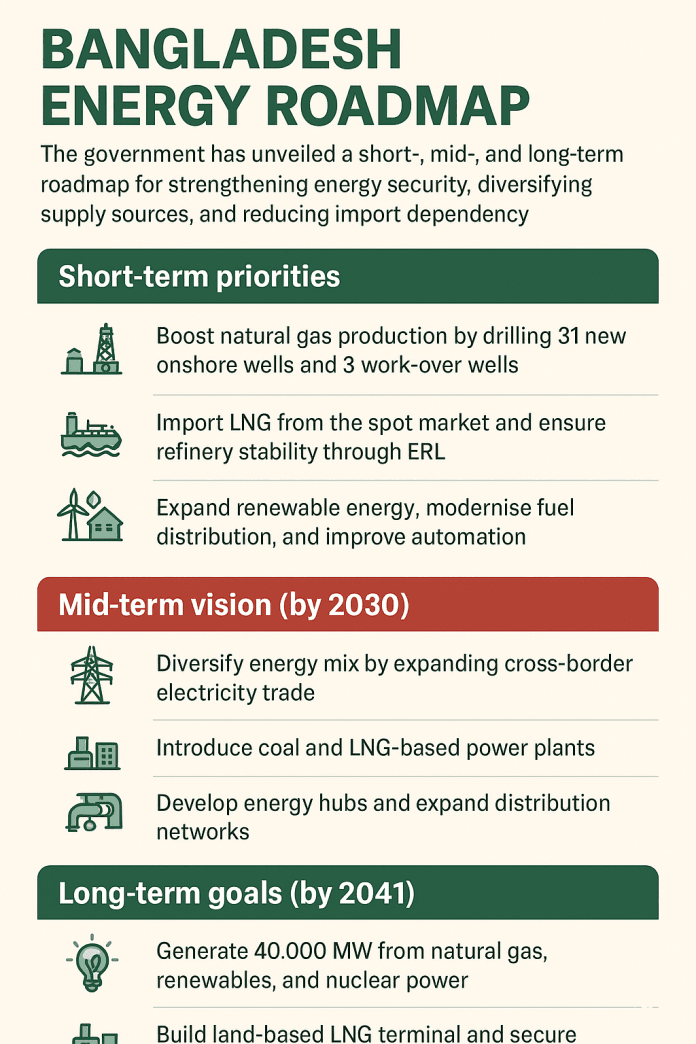Bangladesh has unveiled a comprehensive short-, mid-, and long-term roadmap for its energy sector, aimed at strengthening energy security, diversifying supply sources, and reducing dependence on imports.
The plan prioritises natural gas exploration, LNG imports, refinery expansion, and renewable energy integration to meet growing demand.
Short-term priorities
In the immediate term, the government will boost natural gas production by drilling 31 new onshore wells and three work-over wells, while expanding exploration surveys.
To address urgent supply needs, Bangladesh will import LNG from the spot market under existing public procurement rules and ensure refinery stability through Eastern Refinery Limited (ERL).
Efforts will also focus on modernising fuel distribution, improving automation, and ensuring transparency in management. Energy efficiency measures such as SCADA systems, efficient appliances, and waste-to-energy projects will be promoted. Renewables, particularly solar home systems and biomass, will be expanded.
Land acquisition is being prioritised for LNG terminals, depots, and energy hubs near the Padma Bridge and major airports. The Department of Explosives will be strengthened to ensure safer storage and transport of fuels.
“We are focusing on drilling three dozen work-over wells by June 2026,” said Mohammed Saiful Islam, Secretary of the Energy and Mineral Resources Division, adding that project directors have been instructed to expedite work.
Mid-term vision
By 2030, Bangladesh aims to diversify its energy mix by expanding cross-border electricity trade, strengthening transmission and distribution networks, and introducing coal and LNG-based power plants.
Energy hubs in Cox’s Bazar and Maheshkhali will be developed, alongside new LPG distribution systems and expanded petroleum storage. ERL-II expansion is planned to ensure steady fuel supply.
Pipeline projects include linking Bhola’s gas fields to the national grid through connections to Barishal, Jhalakathi, and Laxmipur. A jet fuel pipeline from Chattogram to Dhaka and LPG pipelines from Mongla to Khulna and Dhaka have also been proposed. A cross-border pipeline from India’s West Tripura to Bangladesh is under consideration.
The government plans to drill 100 new wells and work-over wells by 2028.
Long-term goals
The roadmap’s ultimate goal is achieving primary energy independence. By 2041, Bangladesh targets generating 40,000 megawatt of electricity from a diversified mix of natural gas, renewables, and nuclear power. Offshore and Bay of Bengal exploration will be scaled up, alongside investments in clean coal technology and environmentally friendly fuels.
Plans include securing long-term LNG contracts, exploring green hydrogen for industrial and transport use, and ensuring universal access to affordable primary energy. The government also plans to establish ERL Unit-3 and a land-based LNG terminal.
“We are working to ensure sustainable energy security with a focus on power generation,” said Secretary Saiful Islam. “Our short-term focus is work-over wells, mid-term is utilising Bhola gas, and long-term is onshore and offshore exploration.”
The Ministry of Power, Energy and Mineral Resources will review the country’s gas supply situation at a meeting on Saturday.

